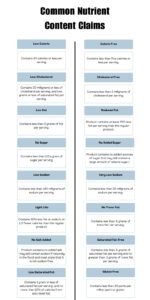
Food and health claims can be extremely informative, but at times vague and confusing. What is considered “low fat”? And is a “light” version of your favorite food actually healthy?
Turns out, claims can be broken down into three categories: health, nutrient content, and structure/function.
- Health Claim: Describes the relationship between a food substance (a food, food component, or dietary supplement ingredient), and reduced risk of a disease or health-related condition.
- Nutrient Content Claim: Describes the level of a nutrient in the product, using terms such as free, high, and low, or they compare the level of a nutrient in a food to that of another food, using terms such as more, reduced, and lite.
- Structure/Function Claim: Describes the role of a nutrient or dietary ingredient intended to affect the normal structure or function of the human body, for example, “calcium builds strong bones.”
Many of us are trying to eat healthier, which means paying closer attention to food labels. By understanding what food claims actually mean, we can then make better food choices.
Below, you will find some of the most common nutrient content claims we come across. If a food is labeled with one of these claims, that’s great! But don’t automatically assume that it is nutritious. For example, a gluten-free muffin isn’t necessarily a healthier version of a regular muffin, it just means it is void of a protein that acts as a binding agent in foods containing certain grains. It could be just as sugary and calorie-dense as the gluten-filled muffin!
If you can, aim to eat as much minimally processed foods as possible, as opposed to processed foods that come in packages or have multiple ingredients. If you don’t have whole-food options, food claims can be a useful tool to help you stay on track with your health goals.


